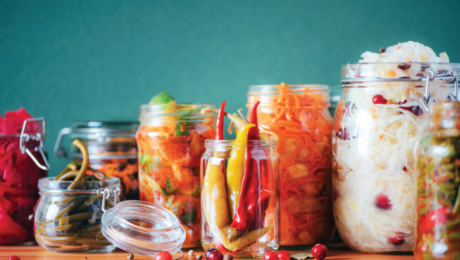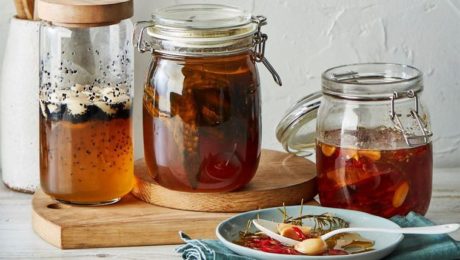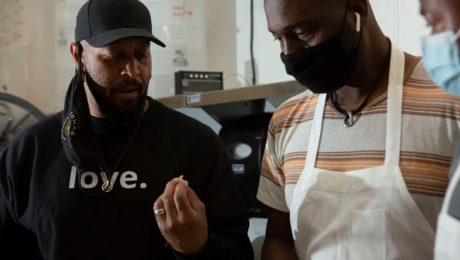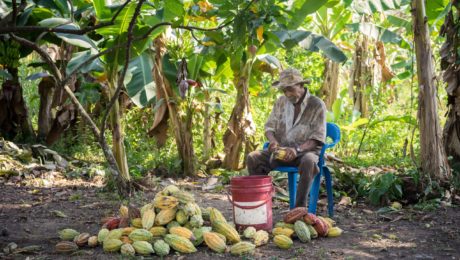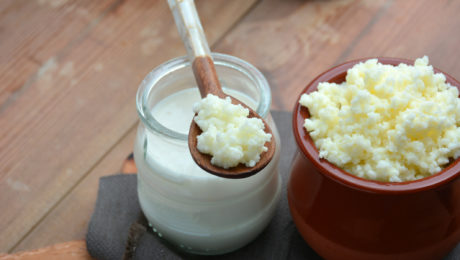The Flavors of Fermentation
From pickling foraged plants to experimenting with koji to vacuum-sealing tempeh, more chefs are experimenting with fermentation. Insights “for menu developers seeking unique concepts and ingredients” were shared during a session at the Research Chefs Association’s RCA+ virtual conference.
Sandor Katz, noted author and educator, discussed how research kitchens can increase their fermentation activities, from creating interesting flavors to expanding food preservation.
“[Fermentation] can elevate the plainest of foods into flavor sensations,” Katz said. “Its uses in culinary traditions around the world are incredibly diverse, and yet visionary chefs are experimenting with exciting new applications of fermentation.”
Read more (Food Business News)
- Published in Food & Flavor
Building a Fermented Brand
Behind every fermented food or beverage is intriguing science that creates a pleasantly tangy taste. Customers want to know all about that chemical process, right?
No. Stop geeking out and appeal to the foodie instead.
“This is about the joy of eating, and so when you over-science me and you over-gut me, I forget the joy of eating. Remind yourself that your most important message is how pleasant, how tasty, how engaging, that’s the pleasure of eating, and then you can tell me how you make that pleasure,” says Sasha Strauss, managing director at Innovation Protocol (a marketing consulting & design agency). Strauss shared his brand strategy tips in the TFA webinar Building a Fermented Brand. He stressed fermented brands need to avoid getting stuck in the “scientific nuance of how you make your products. I’m not saying delete the science, just don’t make it the marquee.”
Alex Corsini, founder of frozen pizza company Alex’s Awesome Sourdough (and TFA Advisory Board member) agrees. Corsini, who moderated the webinar, says he began his brand with a heavy emphasis on the science of fermenting sourdough.
“Our customer didn’t really respond to that. And that’s something I see in fermentation all too often, is people aren’t selling the actual benefit. They want to understand the benefit, so that’s what you lead with,” Corsini advises.
If you’re selling kombucha, for example, share that it’s a feel-good product that will make you feel better than a soda, Corsini says. Don’t make your selling pitch the SCOBY’s technical specifications.
Teach, Don’t Sell
“I don’t understand fermentation. I don’t understand the health benefits. I don’t understand its cultural origins. I don’t understand what section to buy it in. I don’t understand what to eat it with or who to serve it too. Your first duty as a brand is to help me make sense of this, help me understand it,” Strauss says. “It’s not your job to be the sexiest, raciest, the most innovative, it’s your job to help me understand. And where understanding sits in the consumer’s mind is where buying behaviors originate. So the first and most important duty of your brand is to simply help me not feel alone, help me not feel confused, help me not feel overwhelmed.”
By educating the consumer, by inspiring them to learn about fermentation, “they will be indelibly connected to you,” Strauss continues. “They will prefer you. They won’t wonder if your price is a penny cheaper, they’ll prefer you because you’re who they learned from. We buy who we learn from.”
There’s not enough room on a label to detail all the health benefits or the scientific details of a product. But this information can go on a brand’s website, social media page or table-top display at a trade show or farmer’s market.
“I hope that your audience doesn’t hear from you just once,” Strauss says. They should find a video of your product on Instagram, find recipes on your website and see an ad in the local paper. Brands need to create multiple opportunities to engage, “don’t try to cram all of your value in a single channel.”
A New Economy
The COVID-19 pandemic has permanently changed the economy. Consumer lifestyles have changed, too, and these new behaviors create opportunities, especially for fermented products that are healthy and flavorful.
“Historically, if you were trying to build a consumer packaged goods brand, it was really about your resume, your long list of accomplishments , your heritage in farming, your understanding of the chemistry and that was what marked the person, the business, the brand,” Strauss says. “But actually now, it’s really about how you resonate, how I connect with you, how you inspire me, and that doesn’t require a long history, that requires a contemporary participation.”
“In a world where the audience is starting and ending their search digitally, each of the things that you share, post, write about, blog about, video dialogue about, those things are little breadcrumbs that will never go away,” Sasha says. “They’re little trails that lead to your brand, lead to your resources, lead to your understanding and this is powerful.”
Consumers rejected traditional brand loyalties this past year. They’re increasingly open to new brands, curious about new cultural flavors and want healthy food. Critically, Strauss points out, they want to purchase from socially responsible brands. “In a post-covid era, we want a brant to also do good,” he says.
Producers must make conscious choices about the farmers they use — how are they improving soil health? What is the environmental impact of their distribution line?
“Understand you have to make an impact, somehow do good for the world while building business,” Strauss says.
- Published in Business
Fermented Honey Top Ingredient in 2021
Fermented honey topped the list of emerging ingredients in 2021, as presented by food industry intelligence firm Datassential at the Research Chefs Association’s RCA+ conference. Fermented honey is in the “sweet spot” (pun intended) of intersecting larger trends — consumers gravitating to honey as a sweetener and to fermented products for their health benefits.
Read more (Food Business News)
- Published in Food & Flavor
Hand-Brewed Makgeolli in South Korea
A beautiful new video from Eater shows traditional makgeolli being made by hand in South Korea. Master brewer Park Bok-soon runs Boksoondoga with her son, where they make this milky, slightly sweet, alcoholic fermented rice drink .
Boksoondoga uses nuruk, a fermentation starter, said to help avoid hangover symptoms, such as headache and upset stomach. Nuruk ferments for about 15 days before being mixed with rice, and then ferments for another 20 days or so in onggis, traditional Korean pottery.
“Hand brewed makgeolli is more delicious when you put your heart into it so that’s how I started making my makgeolli business,” Bok-soon says. “Alcohol is like a drink with living organisms. I love it.”
Read more (Eater)
- Published in Food & Flavor
Vegan Cheese Matures
Vegan cheese makers are “pushing the limits of those fermentations to create … flavors and textures I’d previously thought impossible,” writes The New York Times food columnist Tejal Rao. She says the “new generation” of vegan cheese is surprisingly tastier than the bland, starchy, mass-produced vegan cheese of the early 2000s.
Missing from those first versions of vegan cheese: fermentation, a key to creating flavor. Vegan cheese now is also aged and ripened like dairy cheese to develop flavors and textures.
The microbes used to give cheeses like Gouda and Brie their distinct flavors are also critical. Vegan cheese cultures are now readily available. Aaron Bullock and Ian Marin (pictured), founders of Misha’s Kind Foods, work with proprietary cultures to create cream cheese and ricotta made from cashew milk.
Read more (The New York Times)
- Published in Food & Flavor
Retail Sales Trends for Fermented Sauces
Shelf-stable fermented sauces are growing tremendously. In the past year, fermented sauces grew 41%, with sales reaching $275 million. Soy sauce still dominates with 70% of the market share, but sales of both fish sauce and gochujang increased over 50%.
“I think a lot of brands are thinking ‘Are we going to hang onto this new [normal], this new baseline?’ This is a segment of products that’s really having its baseline reset,” says Kevin Snodgrass, solutions architect for SPINS. Snodgrass shared insights in a TFA webinar, Retail Trends for Fermented Sauces. “Brands are going to continue to experience this great growth in the months and years ahead.”
The increase is significant — sales growth in the one year from 2019 to 2020 was 5.7%. This improvement is attributable to multiple trends across the food industry — more people are buying healthy food and cooking at home, the American kitchen is becoming more globalized, and more consumers are embracing the unique flavors of fermented sauces, especially those from Asia.
“It definitely coattails a lot on the acceptance and growth of the fermentation market as a whole,” says Jared Schwartz, a TFA Advisory Board member who moderated the webinar. Schwartz is the founder of fermented sauce producer Poor Devil Pepper Co., and director of operations and quality for Farm Ferments, a facility in Hudson, N.Y., that is home to Hawthorne Valley Farm. “As consumers are becoming more open to reaching for fermented foods, kind of the next step is adding a flavorful, fermented hot sauce.”
Brands Growing, but Room for More
The top 10 selling fermented sauce brands in both natural retail grocers (like Whole Foods) and traditional (MULO) outlets (like Wal-Mart and regional grocery chains) are all experiencing double-digit growth. “That’s a great sign,” Snodgrass notes.
Kikkoman, Bragg, San-J, Coconut Kitchen, Lee Kum Kee and Big Tree are among the top 10 brands in both the natural and MULO channels. Smaller brands like Red Boat, Mother-In-Law’s, Ohsawa and Yamasa thrive in the natural channel,; La Choy, BetterBody Foods and Chung Jung One are strong in MULO.
The category is ripe for continued innovation, Snodgrass says. Smaller brands can emerge, even with competition from larger, established brands, so it can be worthwhile to start a fermented sauce brand.
Label Claims & Consumer Education
SPINS found certain product attributes on fermented sauces help sales.. Certified gluten-free fermented sauces grew 40.8%; USDA organic, up 40% and non-GMO increased 33.8%.
Since many sauces don’t put “fermented” on their label, many consumers may not be aware they are, notes Snodgrass. He says that these products could benefit from using “fermented,” as it would suggest that there may be health benefits to the sauces.
Schwartz agrees. He points out Tabasco as a fermented hot sauce, even though producer McIlhenny Company doesn’t market it as such. Educating the consumer would also help the category. Probiotics are a selling point but they confuse buyers. And there’s a clear difference in health benefits between shelf-stable and refrigerated fermented sauces. Refrigerated sauces may have live, beneficial bacteria; shelf-stable ones are pasteurized, killing any good bacteria in the process.
“At the end of the day, I think it comes down to flavor,” Schwartz says. Fermented sauces are “funky and vinegar-free. It’s got this like natural layers of complexity that you can’t really achieve without fermentation.”
- Published in Business, Food & Flavor
Solving Illnesses with Fermentation?
Scientists in Russia and Egypt have developed a functional drink that’s been proven to combat anemia and malnutrition. The juice is made from beet extract, milk and probiotic bacterial strains. The scientists developed a quinoa bread, too. The goal is to keep the beverage and bread affordably priced and get them offered at grocery stores internationally.
“One should bear in mind that we are not creating a medicine, but a natural, functional food product,” said Sobhi Ahmed Azab Al-Suhaimi, professor in the Department of Technology at South Ural State University (SUSU) in Russia. “However, this juice can make up for the lack of iron, zinc, manganese and calcium in the body. One serving of the drink will contain the whole rate [sic] of minerals. Its carbohydrate content is low. Fermented juice will help to overcome anemia and to improve digestion due to probiotics.”
Scientists at SUSU worked with scientists at the University of Alexandria in Egypt. Their findings were published in the Journal of Food Processing and Preservation and Plants.
Read more (Phys.org)
Ferments from India
Have you heard of idli? This fermented and steamed rice and black lentil cake is one of the most popular breakfasts in India. And now, a chef is trying to make it recognized around the world.
The India Times interviewed M Eniyavan, founder of Mallipoo Idli in Chennai, India. Eniyavan created World Idli Day six years ago. He makes over 2,500 varieties of idli, including a tender coconut idli, pizza idli (sans cheese) and even a chocolate idli.
The long fermentation of rice grits with black lentils creates a delicious flavor and has been lauded as “one of the healthiest breakfasts in India.” It’s often served with chutney and sambar (steamed lentil and vegetables tempered with spices.)
Read more (English version, Tennessee Tribune)
- Published in Food & Flavor
Microbes & Chocolate’s Flavor
Love the rich flavor of chocolate? Thank microbes. Scientists are researching how fermentation affects the flavor of chocolate. An article in Scientific American details how a giant cacao seed pod naturally ferments.
Cacao has a wild fermentation, meaning the farmers who harvest the pods “rely on natural microbes in the environment to create unique, local flavors.” Just as grapes take on regional terroir (the characteristic flavor imparted by a place), “these wild microbes, combined with each farmer’s particular process, confer terroir on beans fermented in each location.” Demand for high-quality cacao beans is growing, and producers who make small-batch chocolate with distinctive flavors also are seeing sales growth.
Read more (Scientific American)
- Published in Food & Flavor, Science
“One Grain to Bind Them All”
A new study on kefir found that the individual dominant species of Lactobacillus bacteria in kefir grains cannot survive in milk on their own. The bacteria need one another to create the fermented dairy drink, “feeding on each other’s metabolites in the kefir culture.”
The research, conducted by EMBL (Europe’s laboratory for life and sciences) and Cambridge University’s Patil group and published in Nature Microbiology, illustrates a dynamic of microbes that had eluded scientists. Though scientists knew microorganisms live in communities and depend on each other to survive, “mechanistic knowledge of this phenomenon has been quite limited,” according to a press release on the research.
“Cooperation allows them to do something they couldn’t do alone,” says Kiran Patil, group leader and author of the paper. “It is particularly fascinating how L. kefiranofaciens, which dominates the kefir community, uses kefir grains to bind together all other microbes that it needs to survive — much like the ruling ring of the Lord of the Rings. One grain to bind them all.”
To make kefir, it takes a team. A team of microbes.
The group studied 15 samples of kefir, one of the world’s oldest fermented food products. Below are highlights from a press release on the published results.
A Model of Microbial Interaction
Kefir first became popular centuries ago in Eastern Europe, Israel, and areas in and around Russia. It is composed of ‘grains’ that look like small pieces of cauliflower and have fermented in milk to produce a probiotic drink composed of bacteria and yeasts.
“People were storing milk in sheepskins and noticed these grains that emerged kept their milk from spoiling, so they could store it longer,” says Sonja Blasche, a postdoc in the Patil group and an author of the paper. “Because milk spoils fairly easily, finding a way to store it longer was of huge value.”
To make kefir, you need kefir grains, which must come from another batch of kefir. They cannot be made artificially. The grains are added to milk, to ferment and grow. Approximately 24 to 48 hours later (or, in the case of this research, 90 hours later), the kefir grains have consumed the available nutrients. The grains have grown in size and number, and are removed and added to fresh milk — to begin the process anew.
For scientists, kefir is more than just a healthy beverage: it’s an easy-to-culture model microbial community for studying metabolic interactions. And while kefir is quite similar to yogurt in many ways – both are fermented or cultured dairy products full of ‘probiotics’ – kefir’s microbial community is far larger, including not just bacterial cultures but also yeast.
A “Goldilocks Zone”
While scientists know that microorganisms often live in communities and depend on their fellow community members for survival, mechanistic knowledge of this phenomenon has been quite limited. Laboratory models historically have been limited to two or three microbial species, so kefir offers – as Patil describes – a ‘Goldilocks zone’ of complexity that is not too small (around 40 species), yet not too unwieldy to study in detail.
Blasche started this research by gathering kefir samples from several sources. Though most were obtained in Germany, they may have originated elsewhere, grown from kefir grains passed down through the years..
“Our first step was to look at how the samples grow. Kefir microbial communities have many member species with individual growth patterns that adapt to their current environment. This means fast- and slow-growing species and some that alter their speed according to nutrient availability,” Blasche says. “This is not unique to the kefir community. However, the kefir community had a lot of lead time for coevolution to bring it to perfection, as they have stuck together for a long time already.”
Cooperation is key
Finding out the extent and nature of cooperation among kefir microbes was far from straightforward. Researchers combined a variety of state-of-the-art methods, such as metabolomics (studying metabolites’ chemical processes), transcriptomics (studying the genome-produced RNA transcripts) and mathematical modelling. These processes revealed not only key molecular interaction agents like amino acids, but also the contrasting species dynamics between grains and milk.
“The kefir grain acts as a base camp for the kefir community, from which community members colonise the milk in a complex yet organised and cooperative manner,” Patil says. “We see this phenomenon in kefir, and then we see it’s not limited to kefir. If you look at the whole world of microbiomes, cooperation is also a key to their structure and function.”
In fact, in another paper from Patil’s group (in collaboration with EMBL’s Bork group) in Nature Ecology and Evolution, scientists combined data from thousands of microbial communities across the globe – from in soil to in the human gut – to understand similar cooperative relationships. In this second paper, the researchers used advanced metabolic modelling to show that the co-occurring groups of bacteria, groups that are frequently found together in different habitats, are either highly competitive or highly cooperative. This stark polarization hadn’t been observed before, and sheds light on evolutionary processes that shape microbial ecosystems. While both competitive and cooperative communities are prevalent, the cooperators seem to be more successful in terms of higher abundance and occupying diverse habitats — stronger together!

